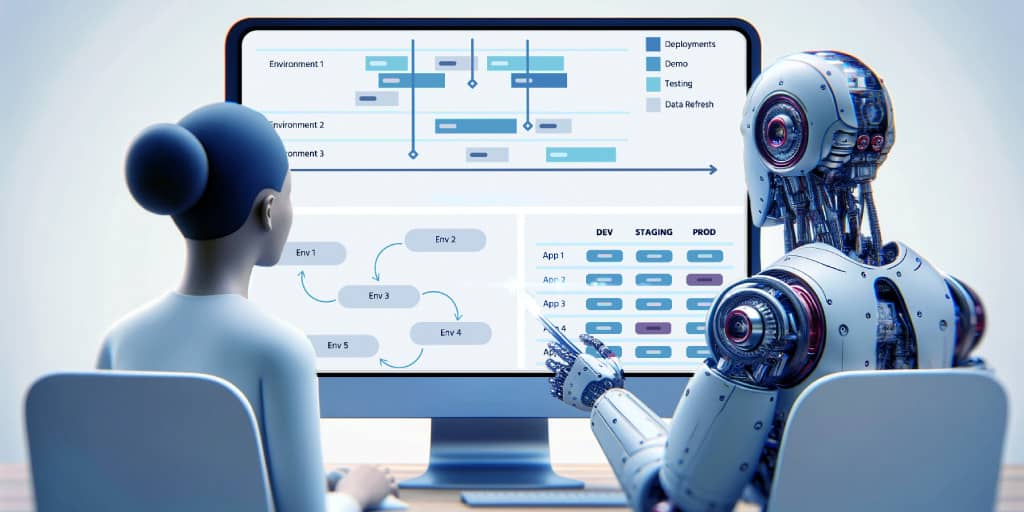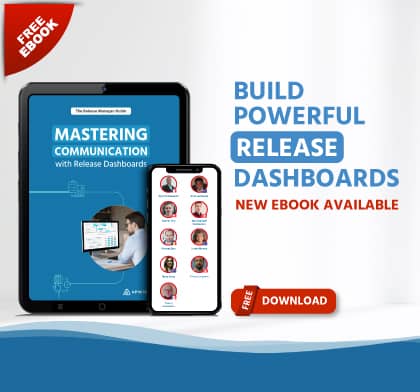Recently, I was part of a project that brought to light the complexities of managing multiple releases and test environments, the struggle with configuration inconsistencies, and the extensive time and energy required to keep our release dashboard updated. This experience sparked a realization: integrating Artificial Intelligence (AI) into Release Management could fundamentally transform the field.
To showcase this, I've engaged Release Management experts from notable software development organizations to contribute their insights on the growing importance of AI in release dashboards. Together, we will explore how AI can revolutionize Release Dashboards and by the end of our discussion, you will gain a comprehensive understanding of the benefits AI offers in crafting robust dashboards for Development, QA and Release teams.
Current State of Release Dashboards
Release dashboards serve as the nerve center for software development and deployment processes, offering a consolidated view of the release status, progress, and key metrics. These dashboards are instrumental for Release Managers, Test Environment Managers, and Test Managers in making informed decisions, ensuring smooth and timely releases. However, despite their critical role, traditional release dashboards face multiple challenges:
These challenges underscore the need for more advanced solutions capable of addressing the dynamic and complex nature of modern software releases. But how AI can help us tackle these challenges? Read further!
From the Field: Release Managers' Perspectives
In our quest to understand the future impact of AI on release dashboards, we reached out to several release managers and asked them the following question: "How will AI and machine learning improve release dashboards in the future?"
The responses we received provide invaluable insights into the anticipated transformations and enhancements AI technologies are expected to bring to release management practices. Below, we share some of their perspectives:
"AI and machine learning will enable dashboards to auto-populate. For instance, if a release for one application might impact another, AI could be configured to detect this.
Currently, this detection is a human task, but with AI, potential conflicts could be automatically identified, preventing scheduling conflicts between releases or applications."
- Linda Mumby, Dialog Information Technology
"AI and machine learning are set to bring transformative changes to release dashboards:
Automated Dashboards: AI has the potential to automate the creation and updating of dashboards, ensuring they are always current and relevant.
Adaptive Evolution: Based on user interactions and needs, AI can help dashboards evolve to better serve their purpose over time.
Proactive Notifications: AI can proactively communicate or notify stakeholders about significant changes or updates on the dashboard.
Enhanced Understanding: With the integration of AI, like chatbots, users can gain a better understanding of the release management processes and the information presented on the dashboards."
- Marco Schefer, Luxury Watches Manufacturer
"Similar to other fields, AI (Artificial Intelligence) and machine learning hold the potential to enhance release dashboards in the future. While I haven't directly worked on AI or ML-related projects, I anticipate the following improvements:
AI and machine learning can analyze historical release data to predict future release outcomes and performance.
They can continuously monitor release metrics and identify deviations from expected outcomes or patterns.
Enhance the testing process by automating test cases, increasing test coverage, and prioritizing critical areas.
Improve the training process by generating quick reference guides, reducing the time needed for training and release.
Assist in making informed decisions during the release process, especially when there are open risks and based on other release metrics.
Automate documentation, including release notes and code changes, saving both time and effort."
- Neha Arora, Anglicare Sydney
"AI has the potential to revolutionize release dashboards by automating many manual checks currently performed during various steps, eliminating tedious activities.
Additionally, a significant aspect of post-production deployment involves analyzing bugs. AI can assist in correlating these bugs with the specific releases or features deployed, streamlining the process and providing more accurate insights."
- Charles Viry, Richemont
"Imagine a world where your environment is seamlessly integrated with a knowledge management system that archives standardized tickets of all past issues and challenges. If a recurring network issue arises, a sophisticated monitoring tool could recognize patterns from past incidents and proactively alert you.
Another dream scenario would be a dynamic release cycle. With the right CI/CD setup, AI could evaluate release readiness by analyzing factors like defect numbers, business process coverage, and the business impact of these errors. This could potentially allow for releases to production ahead of schedule, ensuring teams remain productive and aren't held back by problematic components.
Lastly, with a comprehensive and reliable release process in place, AI could customize responses to stakeholders based on their specific interests. However, a word of caution: while transparency is invaluable, it's essential to ensure that the data doesn't lead to misunderstandings or unnecessary panic. As release managers, we must remember our role as gatekeepers and broadcasters of this information."
- Konrad Sass, Telenet Business
Exploring these insights underscores the transformative impact of AI on release dashboards. These very experts have also contributed to our e-book on Mastering Communication with Release Dashboards, enriching it with their deep knowledge and firsthand experiences.
Transformative Features of AI-Enhanced Release Dashboards
As the experts mentioned, the integration of Artificial Intelligence (AI) into release dashboards introduces a range of transformative features that redefine the efficiency and effectiveness of release management. Here are the five most impactful changes that stand out:
Konrad Sass's vision of a world where AI and machine learning seamlessly integrate with knowledge management systems to alert and inform release processes further exemplifies the potential of AI in release dashboards. This integration not only anticipates issues based on historical patterns but also customizes stakeholder communication, ensuring information clarity and preventing misunderstandings.
These changes and experts comments illustrate the profound impact AI can have on release dashboards, transforming them into more predictive, responsive, and personalized tools.
Challenges & Considerations
As you integrate AI into release dashboards, you face a myriad of challenges and considerations that are essential to the success of this technological transformation.
Managing these challenges and considerations requires a strategic approach, focusing on long-term benefits while addressing immediate hurdles. By prioritizing data integrity, security, user experience, skill development, and financial justification, you can set a solid foundation for successfully incorporating AI into your release dashboards, and reach new levels of performance, and insights.
The Path Forward
The integration of Artificial Intelligence (AI) into release dashboards marks a significant evolution in release management, enhancing operational efficiency, predictive accuracy, and decision-making. Strategic planning and investment in technology and skills are required to navigate challenges such as data quality, privacy, and the complexity of AI systems.
Atlassian Intelligence, with its AI-powered features in tools like Jira, is leading the charge in transforming release management. Jira's AI capabilities facilitate smarter project tracking, automated issue resolution, and improved prioritization, enabling teams to focus on strategic goals. Apwide Golive is preparing to leverage these advanced AI features for enhanced environment management and release processes.
This evolution promises not just to address current challenges but also to redefine the landscape of release management, opening new horizons for innovation, efficiency, and strategic foresight.
Transform your Test Environment Management with Apwide Golive:
Leading companies have already Golive as part of their DevOps toolchain:





Free trial / Free forever up to 10 Jira Cloud users!


